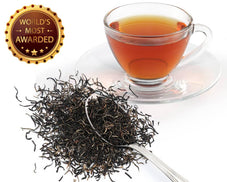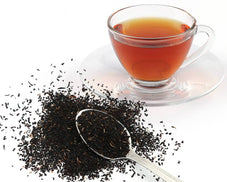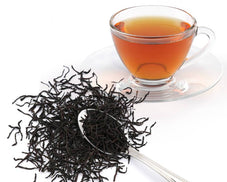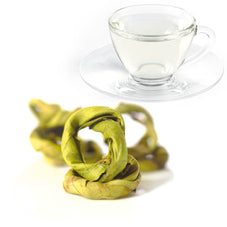
The ultimate guide to select good teas from poor unhealthy teas. Learn how to pick a great cup of tea!
What's the global standard for tea?
Remember the last time you bought clothes? Whenever I'm buying clothes I look for the brand name and then the price, feel, material, etc. Then I rank them the way I want. But the truth is it may not be the best way to rank my choices, but it is based on my fashion likes.
Tea should be different. Because it is something we drink daily and we should be mindful of what goes into our body. This is why you should know what to look for when buying tea. We’ll share our learnings here.
Imagine a million white cups are in front of you filled with red, orange, amber, white colors, and you have the choice to select any. Hmm, how do you find the good and the premium teas from the cheap, poor and unhealthy ones? Is it taste or smell? Or maybe something more?
Tea drinking is a daily experience we cherish. For most people, the critical parameter when evaluating quality is taste. But that does not mean the aroma of it, the effect on the palate and cup color are any less significant. Because all of these complement each other to give us a total sensory experience. Also, keep in mind that health-boosting elements in tea are what makes it the most unique beverage in the world.
The best thing is, over centuries of growing, manufacturing, brewing, and drinking tea, the world has come to some form of agreement on the characteristics that are inherent to high-quality tea. You need a bit of guidance.
Let's look at this in the following way.
Part 1 - Selecting tea samples to taste
- Tea bags vs. loose tea
- Brand
- Location
- Selective handpicking of tea leaves
- Freshness
Part 2 - Tea tasting
- Taste
- Aroma
- Texture
- Cup Colour
Part 1 - Selecting tea samples to taste

1. Tea bags vs. Loose tea
Most of the time, tea bags have tea dust and fannings, which are smaller pieces of tea. These are low-quality teas in general and usually, machine harvested and blended with poor quality unhealthy teas. If you are buying tea bags, make certain that the tea leaves in bags were selectively handpicked, grown in an unpolluted location, and not blended with low-quality unhealthy teas. This is the only way to make sure that teas in tea bags are not of low quality. What you can do is try and buy loose tea whenever possible if you don't know the origin of the tea and how it is processed.
Now, we need to select a few tea vendors.
2. Brand
Easiest would be you asking a friend who's into tea for recommendations. Or you can always do a Google search and analyze the following when browsing.
Look for the brand visibility, availability of tea, reviews, awards won, and most importantly, the location where the tea is grown. These will help you narrow down your search to a few vendors.
Consumers also need to be mindful that brands use blends containing high-quality teas mixed with those of inferior quality. This practice completely removes the effect of the distinctive characters and their health-boosting elements, making the identity of the tea inconsistent and its quality sub-par. Tea blending was initially about bringing two high-quality teas to create a superior tea. But now it has become a way to increase output and profitability by mixing good tea leaves with low-quality and unhealthy tea leaves.
3. The location
The location and craftsmanship hugely influence the quality of tea. Single-origin tea used to be an indication of a good tea, but it is not so much nowadays. This is because most of the eco-systems where teas are grown have become polluted. This causes toxicity in tea leaves, and a majority of health elements are lost from tea leaves.
This is why you need to look for teas that are grown in untainted eco-systems. Locations with high-quality air, soil, and groundwater are diminishing as global pollution levels increase.
4. Selective handpicking of tea leaves
A lot of us don't know this, but most tea harvesting is done using machines to reduce costs and increase production output. Any machine-harvested tea is of low quality because old leaves, infected leaves, twigs, bugs, etc. are all harvested and mixed. But “selectively hand-picking ensures that you pick only the two leaves and a bud at the top of the tea plant. The most antioxidants and health-boosting elements in tea are concentrated in the “Young Two Leaves and a Bud” only. It is purely because of this you need "selectively handpicking of tea leaves" to make a good healthy refreshing cup of tea.
You must look for selectively hand-picked teas when buying because it is what makes your tea a life-changing healthy beverage.
Beyond the criteria of Taste, Aroma, Texture, and Color, tea lovers also need to be mindful of how fresh the tea is and its shelf life. This is critical because, after some time, the tea starts to deteriorate. Ultimately it loses its inherent health qualities and loses its characteristic features.
Fresh teas will have the highest health-boosting antioxidants and other essential minerals and vitamins. The time taken for the teas to reach you is critical because of this. This is not an explicit criterion to judge quality on. But it will be crucial as to how much of the tea’s original condition can be preserved until it reaches the consumer.
Part 2 - Tea Tasting

When evaluating a cup of tea, we can use four of our five senses; Sight, Smell, Taste, and Touch to varying degrees. In order of importance, we could rearrange them as Taste, Smell, Touch, and Sight.
Taste
The all-important flavor! Different flavor notes and palates become apparent as the tea glides over the taste buds. Yes! The experience is magical as it sounds.
Different types of tea will have different flavor profiles. For example, good black tea has deep intense flavor tones, while the best green teas will carry a light veggie and a slight umami taste.
Good quality may mean that differences can be expected, So, We should understand that teas hailing from different parts of the world will taste differently. But that does not mean one is better than the other. It is just that each tea represents the character of the land it grows in, harvesting method, and the characters infused during the tea-making process.
For example, teas grown in the Lumbini tea valley of Ceylon will reflect the characteristics of the Lumbini Valley. Similarly, Keemun tea will reflect the geographic qualities inherent to the Qimen county in Eastern China. The bottom line is that any good tea must unlock different flavor sensations on your tongue as you sip it.
… But not inconsistencies and unpleasantness.
When you cannot notice the flavor or when the tone is unrecognizable, it is a warning that you are drinking low-quality tea. Poor quality tea blending, inconsistent leaf harvesting, and sourcing practices ultimately remove any distinctive characters that could elevate the tea’s quality. Overly harsh or unpleasant chemical tastes may mean that the tea is old or substandard in quality.
1. Aroma
Any high-quality tea will have a distinct aroma. The most significant complementary factor for tea taste is its smell in our experience. For a novice, a tea could either smell good or smell bad. But the real range for aroma is much more extensive where the quality of the tea could be assessed by its aroma during multiple stages. From the dry leaf to the brewed liqueur, the infusion and even the cooled empty cup, the distinct aromatic characters at each stage can be an indication of the tea’s quality.
Its aroma can also gauge the freshness of the tea. As tea ages, the surface moisture on the leaves evaporates, thinning the aromatic strength and reducing the richness of the tea’s dry fragrance. If you feel only a slight aromatic effect, it could be that the tea is low in quality or getting old and stale. Good-quality tea typically releases a rich bouquet of aromas when steeped in hot water, expanding on the unique fragrance of the dry tea leaves.
2. Leaf Appearance, Texture and Palate
The appearance of the dry leaf can trigger signs as to its level of quality. When held in your hand, the leaves should feel smooth, whole, and robust, with a slight substance of weight in them. Feather-light tea denotes that either the tea has been made using a mature leaf or that it is getting old.
You may feel that this factor is less important than taste and aroma, but a tea that feels good on the palate is better enjoyed. Different teas can have different texture profiles. For example, black tea may feel stronger and brisker on the palate than green tea; which would be typically smoother and lighter in body and texture. High-quality teas also have a coating effect on the mouth and throat as texture builds on the palate over each sip. A sense of warmness and comfort will reside while you drink the tea, and even for a short time once you have finished.
3. Cup color
Finally, we look at how the cup or liqueur color matters when gauging the quality of tea. Seemingly unimportant as to its indicative nature of quality, cup color is nevertheless a critical factor that reveals the core essence of the leaf. After centuries of study, experts link it to distinctive palate and aroma profiles. For example, a medium colored tea would be brisk and round in palate, moderately aromatic and floral in flavor tones.
The best way to measure the quality of tea by the color of the liqueur is to brew it in a glass cup or white porcelain. If the tea is of high quality, it should appear bright when held to a light. This is a direct indicator of the enriching nature of the soil the tea was grown in.
Loose mineral molecules diffused in the liquid will reflect light in a manner that makes the tea liqueur appear to glow.
Tea is mostly consumed for its health benefits and wellness lifestyle. This is fast becoming the trend in the world, and this is why retaining the original quality of tea is the most crucial factor.
We must not stop at single-origin teas or unblended teas. If you want a tea that is not just a beverage, but a life-changing drink, then you need to always question the vendor.
Teas that can be procured from locations that have unpolluted air, soil, groundwater hold the best promise of untainted health benefits. But remember that even with the above you require selective hand-picking and innovative craftsmanship to produce the world’s finest teas.
A re’cup’ of the fundamentals
Through the entire course of this blog, the main focus was to help you differentiate between good teas from the poor, unhealthy teas. The core question we addressed was, “what exactly is a high-quality tea?”
What is a High-quality Tea?
-
Teas are grown in unpolluted environments.
-
Selectively handpicked young “Two Leaves and a Bud.”
-
Ethical and sustainable agricultural practices.
-
Ethical management practices.
-
They are processed with a high degree of craftsmanship.
to induce a range of taste, flavor & aromas to suit wider palates.
It is also imperative that you understand that tea is a life-changing beverage with proven health benefits. But only the high-quality teas contain antioxidants & bioactive compounds respectively, such as polyphenols, flavonoids, catechins, etc and L-theanine to boost your health.
The reality of it all is, you don’t become a connoisseur of tea overnight. But with continued application of the knowledge gained with every cup you drink, your familiarity with quality will become something more akin to instinct. The authentic tea experience begins after that.
The tea world is exciting, and it has never made life boring for us at Lumbini Tea Valley.




